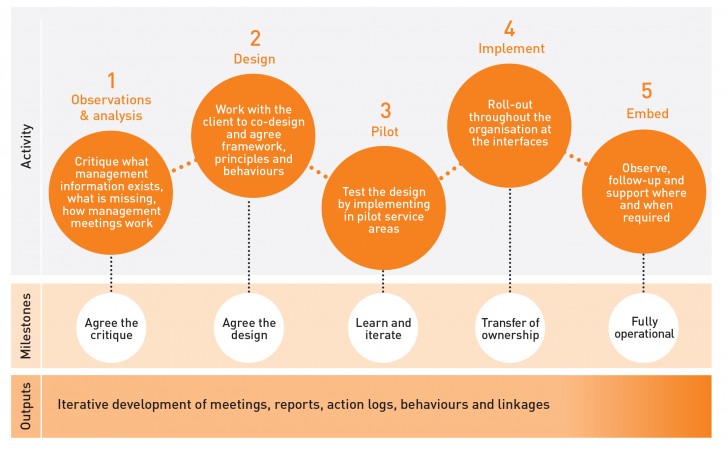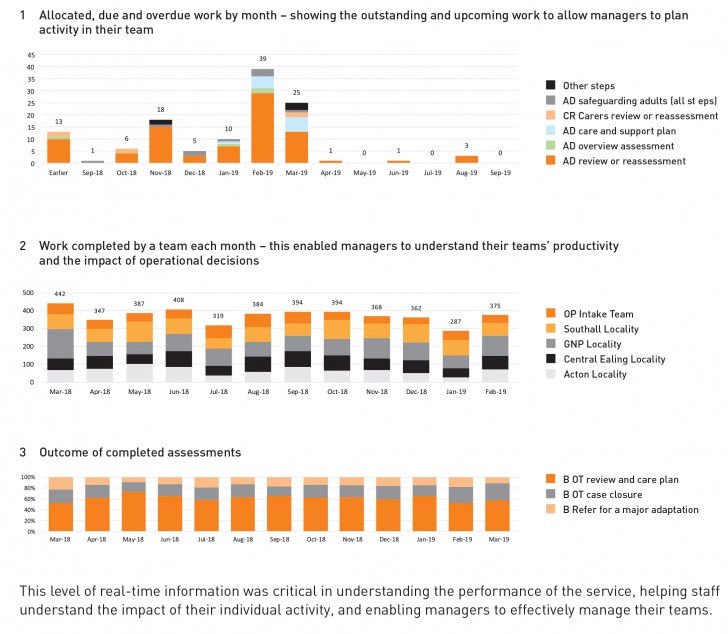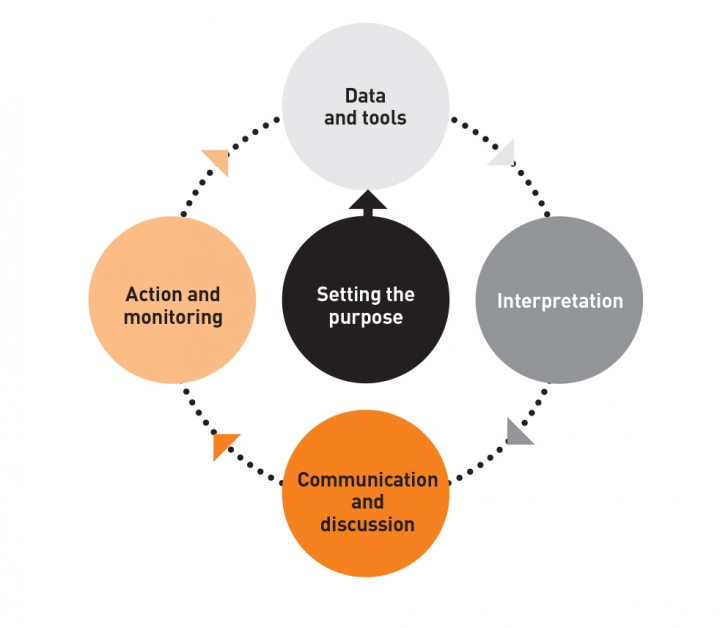"Staff across the service need to understand the little decisions that affect the big numbers."
EDGEWORK Series: Primed Performance Management
Develop staff skills, confidence and behaviours to exploit fully the power of performance data
Cheryl Batt, Head of Disability Services, Ealing Council
Introduction
Across any council’s services, dozens of teams and hundreds of staff make thousands of individual decisions every day.
For councils involved in change programmes, even seemingly small decisions are crucial. The success or failure of change efforts is largely determined by how management decisions are translated into real-life practice on the front line where the services are actually delivered. It is these everyday choices made by staff which cumulatively impact on outcomes for citizens and on the council’s finances.
With so many decisions involved, how can everyone – frontline staff, social workers, managers, finance directors and residents – be satisfied that the right decisions are being made for the service user and for the council? As we and our local government clients have found, there is a significant challenge in managing performance across different services while avoiding micro-managing each interaction and creating a huge managerial bureaucracy. IMPOWER’s answer to this challenge is Primed Performance Management.
Contents
- Introduction
- What is Primed Performance Management?
- Primed – a definition
- What are the benefits?
- How is it different from traditional performance management approaches?
- How does it work?
- Case Study, Adult Social Care, Ealing Council
- Primed Performance Cycle
- What was the impact in Ealing?
- What is EDGEWORK?
What is Primed Performance Management?
Through active Primed Performance Management, teams develop a performance culture. They gather and use performance information as a day-to-day activity, which enables everyone across the organisation to understand how individual actions and decisions impact the system as a whole. To do this, teams use a Primed Performance Management framework for making decisions, shaping behaviours and agreeing principles. Using timely and accurate performance information alongside the adoption of a structured meeting process and embedding of the right behaviours enables fact-based decision making. Staff are then able to interpret data and act on it.
Primed – a definition
We use the word ‘primed’ because our approach resolves the inherent tension between the managerial need to record, monitor and measure activity, and the values that drive the commitment and behaviour of front-line staff. We create an environment where all stakeholders are ‘primed’ to achieve a coherent goal with energy and purpose.
What are the benefits?
Primed Performance Management resolves the inherent tension between two priorities – the managerial need to record, monitor and measure activity, and the values that drive the commitment and behaviour of front-line staff. For example:

- Provides a wealth of information to make informed decisions about running the department: Which teams need more or less support? Which activities are having an impact on the front line? Where is the money going?
- Enables a management team to take direct action to achieve its goals – whether they are financial, outcome-focused or related to improving quality.
- Understanding its own performance enhances an organisation’s capability to work across interfaces – between departments in the same organisation, with partners, and with the people who use services.
How is it different from traditional performance management approaches?
Primed Performance Management is different because it focuses on developing staff skills, confidence and behaviours to exploit fully the power of performance data. It enables them to use data to truly shift the performance of the system or organisation. Principles and behaviours which are typically embedded through the approach include:
- Performance accountability: accountability at service, team and individual level
- Appropriate behaviour: agreeing and sticking to co-written ground rules
- Action orientation: making decisions and taking actions to remove barriers
- Structure and discipline: having a systemic approach to solving problems
- One story: ensuring that the organisation has one version of the truth and not multiple or conflicting datasets or stories
- People focus: staff working together to take actions to improve performance and not relying solely on numerical data
- Fact-based: using evidence to inform actions
- Escalation by exception: teams and individuals at all levels taking responsibility for their performance
- Managing at the interfaces: enabling conversations and decision-making across boundaries between services
How does it work?
Designing and implementing a Primed Performance Management framework is a highly collaborative process, the primary focus of which is getting the right behaviours in place at all levels of the organisation to embed a performance culture.
We start by directly observing teams to understand what management data and other information exists to inform decision-making, identify the behaviours that the management team displays, understand what works and what doesn’t, and spot any obvious gaps. From there, we work with the teams to redesign meeting structures, management data, actions and communications to improve impact.
The five steps we follow are outlined below:
 1. Observations and analysis
1. Observations and analysis
We start by understanding what is currently happening. We observe and analyse the available data, the meetings that already occur, how they are run, how decisions are made, and how subsequent actions are captured, implemented and monitored. At the conclusion of this stage we will produce a review of the current situation and identify what is working well and what needs to be developed.
2. Design
This stage establishes a set of principles that lie at the heart of Primed Performance Management. Having an agreed set of principles ensures that:
- The right information will be available at the right time and shared with the right people
- A new pattern of meetings is established, each with clear terms of reference and agendas so that they can make effective use of the data
- The behaviours that are needed to deliver change are defined, communicated and modelled
A wide range of stakeholders from the Finance Directorate to social workers from across the council are involved in designing the principles. Local co-design is vital, as each council is different, with its own unique challenges, cultures and ways of working. One size does not fit all. It is important that the principles cover both managerial and values-based needs. At the end of this stage, a draft framework design is signed off ready for piloting.
3. Pilot
In this stage we work with a number of teams to test the design. This is an iterative process which involves:
- Working with relevant team managers to make sure the report covers the right areas, is understandable, is timely and enhances their ability to manage their team’s work and outcomes
Trialling Primed Performance Management meetings in order to test the agenda and terms of reference - Most importantly, modelling the behaviours we expect to see in meetings, which are primarily about engaging with the information, taking decisions based on the data, agreeing actions and delivering and monitoring them Any issues with the design can be ironed out during this phase and re-tested before being rolled out. At the end of this stage the draft framework is finalised.
4. Implement
Working with each team in turn, we explain how the co-produced Primed Performance Management system works and describe the new reports and structure, coach the team manager in using the data and support them in embedding the behaviours at team meetings.
This is the most time consuming and intensive stage of work – and the most rewarding for the council staff, as they start to see how individual actions and decisions impact the system as a whole. We monitor teams’ progress and support them until they reach the point where they no longer need our formal support. Depending on staff skills, experience and willingness to engage, this might happen after a few cycles of reports and meetings, but it could require more time.
This stage also includes transferring the ownership of Primed Performance Management as the approach becomes simply ‘business as usual’. In practice, this occurs when reports start being produced in-house (rather than with IMPOWER’s support) and training of council staff is conducted by their colleagues.
5. Embed
In this final stage we look across the organisation and provide light-touch support to any teams or individuals who need additional help. We help refine reports if required and make final adjustments to agendas and terms of reference. Once everyone is confident that they have a sustainable framework in place, we step away completely.
Case Study, Adult Social Care, Ealing Council
IMPOWER worked with the London Borough of Ealing to transform adult social care between April 2017 and March 2019. Using a strengths-based approach, social workers successfully increased the independence of service users. This improved outcomes for the people of Ealing while reducing costs.
The work involved:
- Undertaking an avoidable demand analysis to understand how demand could be reduced and establish the impact on costs
- Designing and delivering programme development activities, including trialling new approaches with teams
- Delivering the implementation phase of Ealing’s ‘Better Lives’ adult social care transformation programme.
A crucial part of delivering the Better Lives programme was establishing the use of Primed Performance Management. We had previously trained social workers and other front-line staff to use a strengths-based approach and had worked with the adult social care management team to improve their finance and performance reporting. However, as the success of the programme was dependent on the hundreds of decisions being made every day within teams, the service needed a better method for tracking and understanding the impact that these changes were having. We started by using what the council already had: some reasonable data, a detailed understanding of the service, an established set of management meetings and team meetings, and a network of managers committed to the programme. We then undertook the following steps:
- Observing and analysing a range of team and management meetings to understand current structures, operations and behaviours.
- Working with staff and stakeholders across the Council to co-design a bespoke set of reports and tools to support staff in achieving the service’s ambition, including clear terms of reference for meetings.
- Piloting the approach with select teams to ensure the approach worked for Ealing.
- Implementing the new approach across the whole Better Lives programme. In doing so, we changed staff behaviours and developed their skills to better analyse, communicate and act on the new information.
- Continuing to provide support to teams as Primed Performance was embedded.
This enabled us to look at each team and understand how they were able to contribute to the service’s goals, how they were performing against a set of targets and objectives and what support they needed. It also gave team managers a set of tools to manage their business – by monitoring their outstanding and upcoming work, effectiveness at completing work, and how much they were spending and on what.
New Reports
We developed a set of performance reports that had two main purposes:
- Help each team understand how it was performing
- Help team managers manage their teams’ work effectively
With each report, our aim was to provide something that was easy to understand and analyse, and could therefore help managers make decisions and see the impact they were having.
Tips for successful implementation
- Generating the data needed represents only a small proportion of the work. More than 80% of the project time was focused on people and behaviours, not numbers.
- Change takes time –some managers and teams will get it straight away, but others need much more support. This can mean three or four months of coaching to get it right.
- It helps to start early – the sooner behaviours are embedded, the sooner management teams can start to deliver their objectives.
- It is critical that there is truly ‘one team’. Finance and performance colleagues need to work alongside front-line social workers and service managers, towards a shared goal. The information, data and impact must come together so that there is only ever one version of the truth.
In the diagram below there are three example reports:

Primed Performance Cycle
Alongside the reports we established a Primed Performance Cycle for each team. We worked side-by-side with team managers, repeating the cycle, until they were comfortable with analysing, communicating and acting on data.

Setting the purpose
Before starting the cycle, we made sure that the service as a whole, and then individual teams, were clear about their purpose. What were the objectives at a service, team and individual level, and what were the targets everyone was working towards?
Data and tools
We then ensured that each team had the right data and tools. All data came from the same source, but reports were tailored depending on the activity within a team. For example, the contact centre data focussed on the number of referrals they were producing and their outcomes, whilst a social work team would focus on the number and outcome of assessments and reviews.
Interpretation
We worked with team managers to develop their skills in interpreting data – providing them with templates and prompt sheets of questions, and then working through these to build their confidence.
Communication
Communication is the area that is often overlooked during change processes, and required significant input. The ability to talk simply, confidently and clearly about data is not a given, so we worked with managers to find the best way for them to get information across to their teams in a way that made sense to them.
Action and monitoring
All of this work would have been pointless if no action resulted from it. Initially, we found that rich discussions were taking place in team meetings but that these were not translating into action. We therefore prioritised making sure that team meetings concluded with clear actions, owners and deadlines, and that these were followed up.
Repeating the cycle
We repeated this cycle with team managers until they were comfortable with it and it became business as usual – a sustainable mechanism for performance managing the service.
What was the impact in Ealing?
Primed Performance Management enabled the Better Lives programme to take relevant and timely decisions that both improve the quality of the service for the user, and control costs for the council, by:
- Creating clarity about performance at the front line. The team now has a clear view of how much work is being completed and by whom, which has helped them to unpick myths and perceptions about everything from the causes of backlogs to the impact of reviews
- Leading to direct action. For example, new data exposed performance variation across teams and enabled managers to act immediately. In one case this turned a net increase in spend into a net decrease within just one month
- Informing strategy. It clearly demonstrated the positive net financial impact that reviews were having at a time when there were doubts about this, and enabled the service to redouble its efforts to undertake reviews
- Creating a cultural change. Staff could measure how well they were doing against targets and felt they were accountable – which also created some friendly competition
Improving productivity. This is particularly true for team managers as they were quickly able to understand team workload; previously they had to navigate individual workloads through the care management system
As a result of this, Ealing Council benefitted from impressive operational and financial outcomes – see below. The adult social care management team now have a structured approach to understanding what is happening across the service. This has enabled them to make more informed decisions about running the department, based on a detailed understanding of what is happening on the front line.
directly saved (plus £6 million indirectly saved) through the Better Lives programme
in average daily spend on placements despite an overall increase in demand
in contacts to the front door through more effective contact routes
in service user reviews, meaning that more people are receiving support relevant to their current needs
What is EDGEWORK?
Drawing on 20 years of insight and impact, EDGEWORK is IMPOWER’s unique approach which helps our clients understand complex problems in order to solve them. Public services can be effective, affordable and sustainable; the key is understanding complexity.
Many might argue that lasting change comes down to robust business cases, strong project management and clear planning. A traditional approach like this is logical and it gives directors and leaders the feeling that they have control. But year after year, research shows that a majority of change projects fail to deliver their promised benefits.
This is because of an illusion that public services are ‘complicated’, and that they can be controlled if the right processes are put in place. At IMPOWER, we reframe public services as ‘complex’ – non-linear systems, where responsibilities are distributed and where success depends on creating the right relationships across and between system boundaries. This reframing enables our clients to achieve better outcomes at lower cost.
IMPOWER’s solutions are cross-boundary, as the distinctive and game-changing work is done at the edges between organisations, people and processes. We therefore call our approach EDGEWORK.
EDGEWORK comprises a set of defined and flexible inventive methods which are deployed as appropriate to local circumstances. Inventive methods are grouped under five competency areas:

Related content
Read more related content from across the site, including in-depth reports, project case studies and articles.